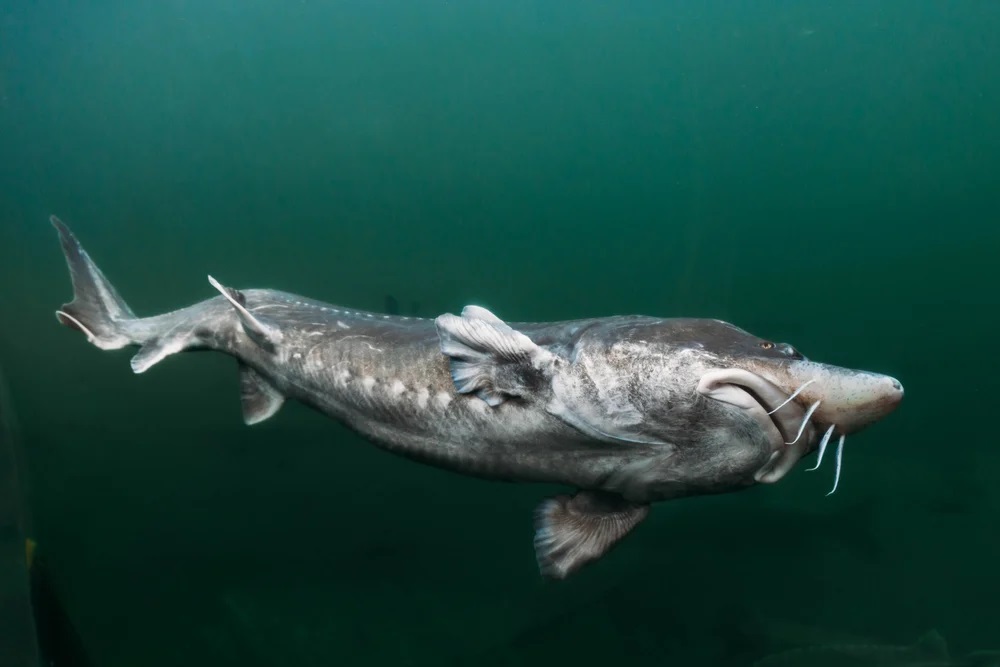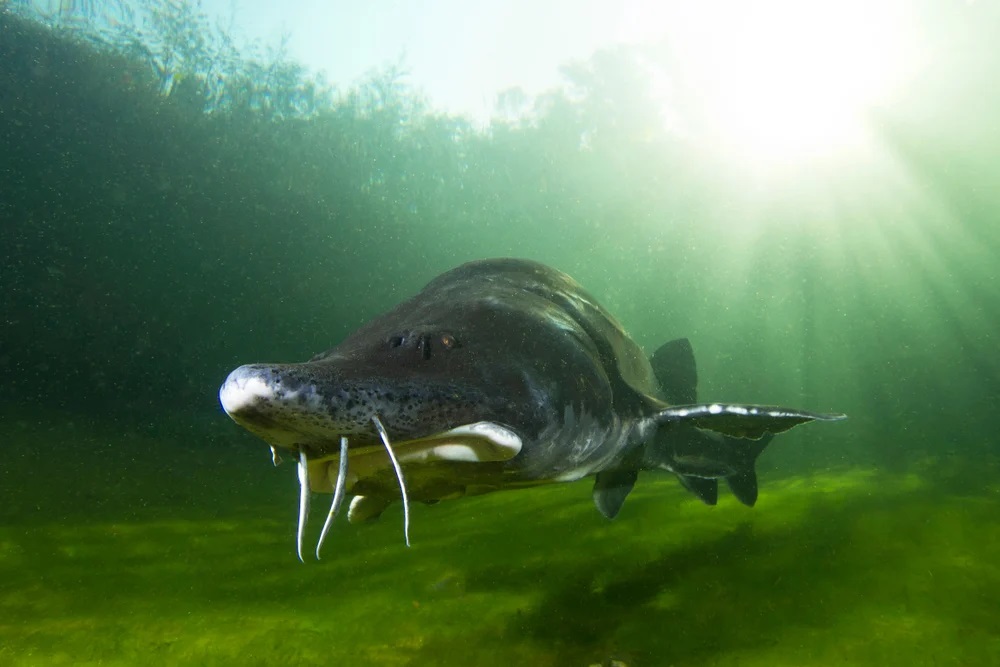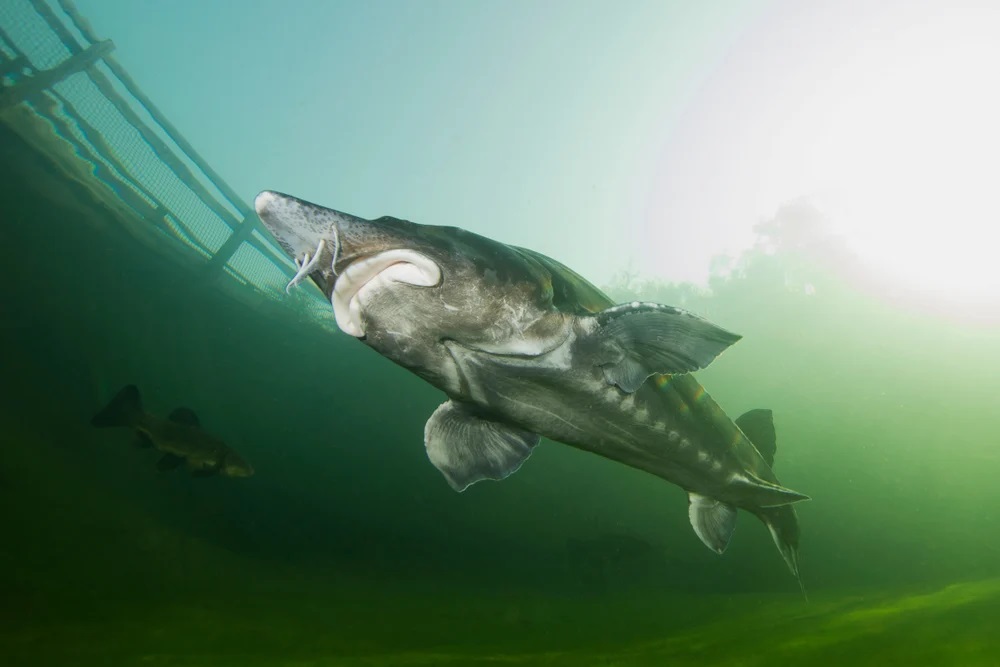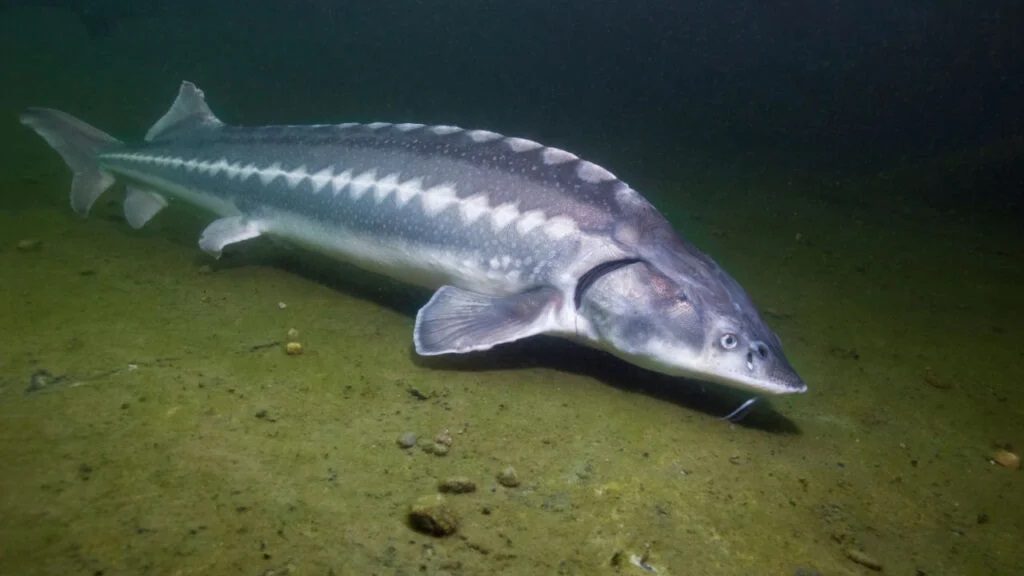Sturgeon have existed for more than 200 million years, making them one of the most ancient fish species on Earth. Their prehistoric history and impressive size have led to numerous myths about their behavior, with some people wondering: Do sturgeon attack humans?
The truth is far more complex than the simple notion of a deadly fish lurking in the water. While sturgeon are not aggressive toward humans, their size, power, and certain behaviors can lead to accidental injuries. Let’s explore the facts in detail.
Certainly! Here’s a table summarizing key facts and figures from the article on sturgeon:
| Fact/Figure | Details |
|---|---|
| Ancient Species | Sturgeon have existed for over 200 million years, making them one of the oldest fish species on Earth. |
| Maximum Size of Beluga Sturgeon | Can reach lengths of up to 20 feet and weigh more than 2,000 pounds. |
| Notable Sturgeon Species | – Atlantic Sturgeon: Found in the Great Lakes, St. Johns River, Florida, and East Coast. – White Sturgeon: Found in the Pacific Northwest. – Beluga Sturgeon: Native to the Caspian Sea. – Gulf Sturgeon: Found in the Suwannee River, Florida. |
| Sturgeon Breaching Behavior | Sturgeon can jump out of the water in a behavior known as breaching, which can lead to accidental injuries. |
| Common Breaching Theories | – Parasite removal – Predator evasion – Communication during breeding season – Migration assistance |
| Sturgeon’s Natural Feeding Behavior | Sturgeon are bottom-feeding fish, relying on their barbels to detect food like small fish, insects, and mollusks. |
| Sturgeon Habitat Locations | – Caspian Sea – Mississippi River – Great Lakes – Suwannee River, Florida – St. Johns River, Florida – Volga River |
| Notable Sturgeon-Involved Incidents | – October 26, 2024: A breaching sturgeon struck a boat in the Suwannee River, causing passengers to fall into the water. – 1997: A breaching Beluga Sturgeon injured multiple people in the Volga River. |
| Safety Tips for Boating | – Slow down in sturgeon habitats. – Stay alert in areas with high sturgeon populations. – Exercise caution in shallow waters. |
| Safety Tips for Swimming | – Avoid swimming in sturgeon breeding and migration zones. – Stay informed about local sturgeon activity. – Wear safety gear like life jackets. |
| Risk Areas for Human-Sturgeon Interaction | – Great Lakes – Mississippi River – Suwannee River, Florida – St. Johns River, Florida |
What Are Sturgeon?
The Ancient Fish Species
Sturgeon belong to the family Acipenseridae, a group of ancient fish that includes some of the largest and longest-living species in the aquatic world. These fish can live for decades, and some species, such as the Beluga Sturgeon, can reach lengths of up to 20 feet and weigh over 2,000 pounds. Sturgeon are widely distributed across the globe, with species found in the Caspian Sea, Black Sea, Great Lakes, and Mississippi River.
Notable species include:
- Atlantic Sturgeon: Found in the Great Lakes, St. Johns River, Florida, and along the U.S. East Coast, these sturgeon are famous for their size and historical importance in the fishing industry.
- White Sturgeon: Known for reaching 20 feet in length, these massive fish inhabit rivers and lakes in the Pacific Northwest.
- Beluga Sturgeon: Native to the Caspian Sea, these are the largest sturgeon species and are known for their prized roe, which is used to make caviar.
- Gulf Sturgeon: These sturgeon primarily live in the Suwannee River, Florida, and are recognized as an endangered species due to habitat loss and overfishing.

Image Source:www.americanoceans.org
Physical Features and Behavior
Sturgeon are bottom-feeding fish, meaning they primarily feed on smaller fish, mollusks, and aquatic insects. They are equipped with specialized barbels (whisker-like sensors) around their mouths that help them detect food on the riverbed. Their bodies are covered with bony scutes, which provide protection from predators, giving them a primitive, armored appearance. Despite their size, sturgeon are not predatory in the sense that they do not hunt larger animals, including humans.
Are Sturgeon Dangerous to Humans?
Debunking the Myth of Aggression
Sturgeon are often misunderstood. Given their large size and strength, many people assume that sturgeon might be a threat to humans. However, sturgeon are not aggressive fish. They do not actively seek out or attack humans. They are primarily concerned with finding food and reproducing, not with engaging with large creatures like humans.
That said, their size and behavior can still pose a risk, though this risk is more often the result of accidental interactions rather than aggressive actions. Sturgeon are simply too large, and their behavior too unpredictable at times, for humans to completely avoid the potential for harm.
When Do Accidental Injuries Happen?
Accidental injuries most commonly occur when humans are boating or swimming in sturgeon habitats, especially during times when sturgeon are more active, such as during their breeding seasons. Breaching—when sturgeon leap out of the water—poses the biggest threat to humans. If a large sturgeon breaches near a swimmer or a boat, it can cause serious injury or damage.
Natural Behavior of Sturgeon
Breaching: Why Do Sturgeon Jump Out of the Water?
One of the most fascinating aspects of sturgeon behavior is their tendency to breach—jumping out of the water. This behavior has puzzled scientists for years, and while we don’t have all the answers, several theories have been proposed to explain why sturgeon breach:
- Parasite Removal: Breaching may help sturgeon remove parasites or debris from their bodies.
- Predator Evasion: While sturgeon are not typically hunted by humans, breaching could be a way for sturgeon to escape predators.
- Communication: Some researchers believe breaching could be a form of communication, particularly among sturgeon during the breeding season.
- Migration: In some cases, sturgeon may breach to help propel themselves during long migratory journeys, especially when traveling through rivers like the Mississippi River or Danube River.
During migration or feeding seasons, sturgeon are particularly active. Their breaching can be unexpected, leading to potential interactions with humans. Rivers like the Suwannee River, Florida, St. Johns River, Florida, and the Great Lakes are areas known for having high concentrations of sturgeon, making them more prone to breaching and accidental encounters.
Sturgeon’s Natural Habitat and Feeding Behavior
Sturgeon are bottom-feeders, spending most of their time near the riverbed searching for food. They primarily feed on small fish, insects, mollusks, and other organisms found in the substrate. Their torpedo-shaped bodies and flat underside allow them to move efficiently along the riverbed, where they use their sensitive barbels to detect prey. They do not typically interact with the surface waters where most humans swim or boat, but this does not eliminate the possibility of an accidental encounter.
Despite their lack of aggression, sturgeon may act in ways that can cause harm. Their non-aggressive nature doesn’t protect boaters and swimmers from the physical risks of a sturgeon’s size and sudden movement.

Image Source:www.americanoceans.org
Accidental Interactions Between Sturgeon and Humans
The Risk to Boaters
While sturgeon aren’t predatory, their size and natural behaviors can pose a danger to those on boats. Boaters, especially those in small craft, are at risk when sturgeon leap from the water or swim with force near their vessels. Collisions can lead to capsizing or physical injuries, especially if a large sturgeon strikes the boat with significant force.
The risk is highest in areas where sturgeon populations are dense, such as the Great Lakes, Mississippi River, and St. Johns River, Florida. These locations are prime habitats for sturgeon, particularly during migration and feeding periods. Boat operators should always exercise caution and stay aware of their surroundings.
The Risk to Swimmers
Swimming in rivers that are home to sturgeon carries its own set of risks. While sturgeon generally avoid human contact, their breaching behavior can lead to accidental collisions with swimmers. A large fish leaping from the water unexpectedly can cause serious harm.
In areas like the Suwannee River, Florida and Great Lakes, where sturgeon populations are known to be active, swimmers should be particularly cautious. While rare, injuries resulting from breaching sturgeon have been reported, and these incidents underscore the importance of staying alert when in waters that are known to harbor these ancient fish.
Notable Incidents Involving Sturgeon and Humans
Case Studies of Sturgeon-Related Injuries
- October 26, 2024: In Suwannee River, Florida, a recreational boat was struck by a breaching sturgeon. The fish collided with the boat’s side, throwing the passengers into the water. While the passengers were not seriously injured, the incident serves as a reminder of the unpredictable nature of sturgeon behavior.
- 1997: On the Volga River, a Beluga Sturgeon breached and struck a small fishing boat, leading to multiple injuries. The incident drew attention to the risks faced by fishermen and boaters in areas with high sturgeon populations.
These incidents highlight the need for awareness and caution in areas where sturgeon are known to be active.
Safety Tips for Avoiding Sturgeon-Related Injuries
While sturgeon are not dangerous by nature, their size and behavior can lead to injuries. Here are some tips to help you stay safe while boating or swimming in areas with sturgeon populations:
Boating Safety Tips
- Slow Down: Reducing your boat speed, especially in known sturgeon habitats, can help avoid accidental collisions with breaching fish.
- Stay Alert: Always be aware of your surroundings, particularly in areas like the Great Lakes and Suwannee River where sturgeon populations are higher.
- Use Caution in Shallow Waters: Breaching sturgeon are more likely to occur in shallow areas. Be extra cautious in these zones.
Swimming Safety Tips
- Avoid Breeding and Migration Zones: If possible, avoid swimming in rivers during sturgeon breeding seasons. Suwannee River and St. Johns River are particularly high-risk areas.
- Stay Informed: Research local sturgeon activity before entering the water. Many regions post warnings during high-risk seasons.
- Wear Safety Gear: Always wear a life jacket when swimming or boating in areas known for sturgeon populations.
General Safety Guidelines
- Follow Local Regulations: Many areas with sturgeon populations have specific fishing, boating, and swimming regulations. Always stay informed and follow these guidelines to ensure your safety and the protection of sturgeon habitats.
- Respect the Wildlife: While sturgeon are not actively aggressive, they are part of fragile ecosystems. Respect local conservation efforts and avoid disturbing their natural habitats.

Image Source:www.americanoceans.org
FAQs
1. How dangerous are sturgeons?
Sturgeons are generally not dangerous to swimmers, but they can pose a risk to boaters, as they may jump out of the water and cause injuries.
2. Have sturgeons got teeth?
Sturgeons do not have teeth; they are slow-moving, bottom-dwelling fish that feed on smaller aquatic creatures.
3. Are sturgeons gentle?
Despite their massive size, sturgeons are gentle creatures, often referred to as “living dinosaurs,” but they are endangered due to overfishing and habitat loss.
4. Why do people not eat sturgeon?
Sturgeon populations are critically endangered, mainly due to poaching for caviar, and their meat can contain harmful toxins like mercury and PCBs.
5. What happens if you catch a sturgeon?
If you catch a sturgeon, it’s important to release it safely back into the water, especially for protected species like Atlantic and shortnose sturgeons.
6. Is sturgeon a shark?
No, sturgeons are not sharks; they are bony fish with minimal true bone structure, unlike the cartilaginous sharks.
7. Are sturgeon caviar eggs?
Sturgeon eggs are specifically known as caviar, which is a delicacy, unlike other fish eggs like salmon roe, which are not considered true caviar.
8. Are sturgeons male or female?
Sturgeon sex can be determined by the shape of their urogenital openings, with males having a Y-shape and females an O-shape.
9. Are sturgeon dinosaurs?
Sturgeons are often called “living dinosaurs” because they have existed for over 200 million years and have changed very little.
10. Are sturgeon fish poisonous?
While sturgeon are not inherently poisonous, they can contribute to ciguatera poisoning, like many other fish species in tropical waters.
11. What is the biggest sturgeon ever caught?
The largest recorded white sturgeon was over 14 feet long and weighed more than 1,500 pounds, with reports suggesting some may reach 20 feet.
12. What happens to sturgeon after caviar?
After harvesting caviar, female sturgeons are often killed, which contributes to their endangered status, as they can’t reproduce afterward.
13. How rare is a sturgeon?
Sturgeons are rare and endangered, with all five U.S. Atlantic sturgeon populations listed as threatened under the Endangered Species Act.
14. What diseases do sturgeon fish get?
Sturgeons can suffer from viral diseases such as white sturgeon iridovirus and herpesvirus, which affect their health.
15. Is sturgeon a good fish to eat?
Sturgeon meat is nutritious and flavorful, and its roe is famous for making high-end caviar, one of the world’s most prized delicacies.
16. Do sturgeons have blood?
Yes, sturgeons have blood, and their blood cells consist of erythroid, monocytoid, lymphoid, and granuloid types.
17. Do sturgeons have eyes?
Sturgeons have small eyes, and they are equipped with four barbels on their snout to help them sense food on the riverbed.
18. What happens to the fish after the caviar eggs have been harvested?
Most sturgeons are killed after their eggs are harvested for caviar, contributing to their decline in the wild due to slow reproductive cycles.
19. Are sturgeons like sharks?
Though sturgeons share some similarities with sharks, such as their primitive appearance, they are actually bony fish and not cartilaginous like sharks.
20. Why do people not eat sturgeon?
Sturgeon are often avoided for consumption due to the risk of accumulating toxins like mercury in their fatty tissues, making them less safe to eat.

Image Source:www.americanoceans.org
Conclusion
Sturgeon are remarkable creatures that have thrived on Earth for more than 200 million years. While these fish are not aggressive toward humans, their large size and unpredictable breaching behavior can result in accidental injuries. By understanding their natural behaviors, staying informed about their habitats, and practicing safe boating and swimming habits, humans can coexist with these prehistoric fish without unnecessary risk.
Whether you’re exploring the Great Lakes, the Mississippi River, or the Caspian Sea, always remain aware of sturgeon activity and take appropriate precautions. By doing so, you’ll minimize the risk of injury and be able to appreciate these ancient fish without fear.
Read more knowledgeable blogs on Flowy Magazine

James Clair is a passionate writer and researcher with a deep fascination for animal behavior and its intricate connection to human life. With a background in [relevant field of study, e.g., zoology, psychology, ethology], James has spent years studying the natural world, focusing on how animals’ actions and instincts impact human emotions, behavior, and society.
His expertise in [specific topics or regions of focus, e.g., canine psychology, animal communication, wildlife conservation] has led to numerous published works and collaborations with renowned researchers and institutions. Through his work at Flawy Magazine, James aims to bridge the gap between scientific research and public understanding, offering insightful, accessible articles that explore the complex relationship between humans and animals.
When he’s not writing, James enjoys [personal hobbies or interests, e.g., hiking in nature, volunteering at animal shelters, photography] and is an advocate for [cause or charity related to animals or conservation]. His mission is to inspire readers to see animals not just as companions or creatures of the wild, but as beings whose behavior holds valuable lessons for us all.









